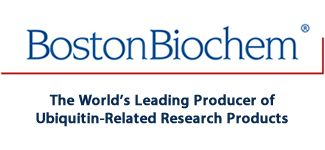
Recombinant Human Ubiquitin Mutant with K29 only Protein, CF Summary
Product Datasheets
Carrier Free
CF stands for Carrier Free (CF). We typically add Bovine Serum Albumin (BSA) as a carrier protein to our recombinant proteins.Adding a carrier protein enhances protein stability, increases shelf-life, and allows the recombinant protein to be stored at a more dilute concentration.The carrier free version does not contain BSA.
In general, we advise purchasing the recombinant protein with BSA for use in cell or tissue culture, or as an ELISA standard.In contrast, the carrier free protein is recommended for applications, in which the presence of BSA could interfere.
UM-K290
| Formulation | Lyophilized from a solution in deionized water. |
| Reconstitution | Reconstitute at10 mg/mL in an aqueous solution. |
| Shipping | The product is shipped at ambient temperature. Upon receipt, store it immediately at the temperature recommended below. |
| Stability & Storage: | Use a manual defrost freezer and avoid repeated freeze-thaw cycles.
|
Reconstitution Calculator
Background: Ubiquitin
Ubiquitin is a 76 amino acid (aa) protein that is ubiquitously expressed in all eukaryotic organisms. Ubiquitin is highly conserved with 96% aa sequence identity shared between human and yeast Ubiquitin, and 100% aa sequence identity shared between human and mouse Ubiquitin (1). In mammals, four Ubiquitin genes encode for two Ubiquitin-ribosomal fusion proteins and two poly-Ubiquitin proteins. Cleavage of the Ubiquitin precursors by deubiquitinating enzymes gives rise to identical Ubiquitin monomers each with a predicted molecular weight of 8.6 kDa. Conjugation of Ubiquitin to target proteins involves the formation of an isopeptide bond between the C-terminal glycine residue of Ubiquitin and a lysine residue in the target protein. This process of conjugation, referred to as ubiquitination or ubiquitylation, is a multi-step process that requires three enzymes: a Ubiquitin-activating (E1) enzyme, a Ubiquitin-conjugating (E2) enzyme, and a Ubiquitin ligase (E3). Ubiquitination is classically recognized as a mechanism to target proteins for degradation and as a result, Ubiquitin was originally named ATP-dependent Proteolysis Factor 1 (APF-1) (2,3). In addition to protein degradation, ubiquitination has been shown to mediate a variety of biological processes such as signal transduction, endocytosis, and post-endocytic sorting (4-7).
This Ubiquitin mutant contains only a single lysine, K29, with all other lysines mutated to arginine. This mutation renders Ubiquitin able to form poly-Ubiquitin isopeptide chains with other Ubiquitin molecules only via the K29 lysine.
- Sharp, P.M. & W.-H. Li. (1987) Trends Ecol. Evol. 2:328.
- Ciechanover, A. et al. (1980 ) Proc. Natl. Acad. Sci. USA 77:1365.
- Hershko, A. et al. (1980) Proc. Natl. Acad. Sci. USA 77:1783.
- Greene, W. et al. (2012) PLoS Pathog. 8:e1002703.
- Tong, X. et al. (2012) J. Biol. Chem. 287:25280.
- Wei, W. et al. (2004) Nature 428:194.
- Wertz, I.E. et al. (2004) Nature 430:694.
- Arnason T., et al. (1994) Mol. Cell. Biol. 14:7876-7883.
- Spence J., et al. (1995) Mol. Cell. Biol. 15:1265-1273.
- Russel N.S., et al. (2004) Biochemistry 43:4844-4854.
FAQs
No product specific FAQs exist for this product, however you may
View all Proteins and Enzyme FAQsRecombinant Enzymes
Recombinant Human His6-USP7 Protein, CF
Recombinant Human His6UBE2S Protein, CF
Recombinant Human Isopeptidase T/USP5 Protein, CF
Recombinant Human STAM-1 Protein, CF
Recombinant Human Ubiquitin Activating Enzyme (UBE1), CF
Recombinant Human His6-UBE2N/UBE2V2 Complex Protein, CF
Recombinant Human His6-UAF1 Protein, CF
Recombinant Human UCH-L3 Protein, CF
Recombinant Human UBE2K/E2-25K Protein, CF
Reconstitution Buffers
Reconstitution Buffer 1 (PBS)
Reviews for Recombinant Human Ubiquitin Mutant with K29 only Protein, CF
There are currently no reviews for this product. Be the first toreview Recombinant Human Ubiquitin Mutant with K29 only Protein, CF and earn rewards!
Have you used Recombinant Human Ubiquitin Mutant with K29 only Protein, CF?
Submit a review and receive an Amazon gift card.
$25/€18/£15/$25CAN/¥75 Yuan/¥1250 Yen for a review with an image
$10/€7/£6/$10 CAD/¥70 Yuan/¥1110 Yen for a review without an image
ebiomall.com






>
>
>
>
>
>
>
>
>
>
>
>
可分为以下几个类群:(1)依赖DNA的DNA聚合酶;(2)依赖RNA的DNA聚合酶;(3)依赖DNA的RNA聚合酶;(4)依赖RNA的RNA聚合酶。前两者是DNA聚合酶,它使DNA复制链按模板顺序延长。如在原核生物中仅就大肠杆菌中已被发现的就有三种(分别简称为PolⅠ,PolⅡ和PolⅢ等);DNA聚合酶只能在有引物的基础上,即在DNA或RNA引物的3′-OH延伸,这DNA的合成方向记为5′→3′。换言之DNA聚合酶催化反应除底物(αNTP)外,还需要Mg2+ 、模板DNA和引物,迄今细胞内尚无发现可从单体起始DNA的合成。同样,上述(3)和(4)是催化RNA生物合成反应中最主要的RNA合成酶,它们以四种三磷酸核糖核苷(NTP)为底物,并需有DNA模板以及Mn2 及Mg2 的存在下,在前一个核苷酸3′-OH与下一个核苷酸的5′-P聚合形成3′,5′-磷酸二酯键,其新生链的方向也是5′→3′。RNA聚合酶也大量存在于原核和真核生物的细胞中。如大肠杆菌RNA聚合酶分子量4.8×105,由5条多肽链组成,分别命名为α,α,β,β′,和γ,全酶可用α2ββ′λ表示。真核生物RNA聚合酶分子大于5×105,由10~12个大小不等亚基组成。聚合酶除作为自然界生命活动中不可缺少的组分外,在实验室中大多用作生命科学研究的工具酶类之一。
但是也有以RNA为模板的DNA聚合酶和RNA聚合酶 (也就是反转录酶和RNA依赖的RNA聚合酶),它们的结合位点在RNA上.
也就是说,模版是谁,结合位点就在谁上。
2.结合位点就是启动合成DNA或者RNA的碱基序列,如RNA聚合酶结合位点是转录起始位点,是一段特殊的位于编码基因上游的DNA序列.这段DNA序列可以结合RNA聚合酶,从而起始转录过程.经典的RNA聚合酶结合位点是TATA box.
TATA box是编码序列前的4个碱基.在大多数生物的基因前面都有TATA着4个碱基序列的存在,它就是一个RNA聚合酶结合位点.
可分为以下几个类群:(1)依赖DNA的DNA聚合酶;(2)依赖RNA的DNA聚合酶;(3)依赖DNA的RNA聚合酶;(4)依赖RNA的RNA聚合酶。前两者是DNA聚合酶,它使DNA复制链按模板顺序延长。如在原核生物中仅就大肠杆菌中已被发现的就有三种(分别简称为PolⅠ,PolⅡ和PolⅢ等);DNA聚合酶只能在有引物的基础上,即在DNA或RNA引物的3′-OH延伸,这DNA的合成方向记为5′→3′。换言之DNA聚合酶催化反应除底物(αNTP)外,还需要Mg2+ 、模板DNA和引物,迄今细胞内尚无发现可从单体起始DNA的合成。同样,上述(3)和(4)是催化RNA生物合成反应中最主要的RNA合成酶,它们以四种三磷酸核糖核苷(NTP)为底物,并需有DNA模板以及Mn2 及Mg2 的存在下,在前一个核苷酸3′-OH与下一个核苷酸的5′-P聚合形成3′,5′-磷酸二酯键,其新生链的方向也是5′→3′。RNA聚合酶也大量存在于原核和真核生物的细胞中。如大肠杆菌RNA聚合酶分子量4.8×105,由5条多肽链组成,分别命名为α,α,β,β′,和γ,全酶可用α2ββ′λ表示。真核生物RNA聚合酶分子大于5×105,由10~12个大小不等亚基组成。聚合酶除作为自然界生命活动中不可缺少的组分外,在实验室中大多用作生命科学研究的工具酶类之一。向左转|向右转
不同点:
1、作用底物不同。RNA聚合酶底物是NTP;DNA聚合酶底物是dNTP。
2、RNA聚合酶作用不需要引物,而DNA聚合酶作用需要引物。
3、RNA聚合酶本身具有一定的解旋功能,而DNA聚合酶没有,当需要解开双链的时候要解旋酶和拓扑异构酶的帮助。
4、RNA聚合酶只具有5‘到3’端的聚合酶活性,而DNA聚合酶不仅有5‘到3’端的聚合酶活性,还具有3‘到5’端的外切酶活性。保证DNA复制时候校对,所以复制的忠实性高于转录的。
5、RNA聚合酶通常作用于转录过程;DNA聚合酶通常作用于DNA复制过程。
再来说真核生物,真核生物的DNA聚合酶分为α,β,γ,δ,ε,.首先我来说三个和原核生物中的Ⅰ,Ⅱ,Ⅲ功能相同的酶.ε类似于原核生物DNA聚合酶Ⅰ,β类似于原核生物DNA聚合酶Ⅱ,δ类似于原核生物DNA聚合酶Ⅲ.α具有引物酶活性,而γ则是作为复制真核生物线粒体内的DNA所需要的酶.









